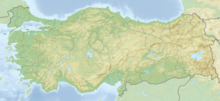Alara Han
Coordinates: 36 ° 41 ′ 32 ″ N , 31 ° 43 ′ 25 ″ E
The Alara Han is a caravanserai (Turkish Han ) on the Alara River in southern Turkey . Han was in the years 1230/31 under the Seljuks - Sultan Ala ad-Din Kai-Qubad I. built.
location
The Alara Han is located a good 40 km northwest of the coastal city of Alanya and approx. 16 km (distance) from the Mediterranean coast at a height of approx. 36 m in the southern foothills of the Taurus Mountains .
history
In the 13th century, the first Turkish empire reached its greatest extent on Asian Minor soil with the conquest of Antalya and Alanya . Since many cities were deserted, Ala ad-Din Kai-Qubad I had fortified caravanserais built along the trade routes, which were about a day's journey apart. The Alara Han marks the junction of the old pass road to the Seljuk capital Konya .
For a while, Alara Han housed restaurants and stalls. A construction company from Ankara restored it between 1998 and 2000 in return for a 49-year right of use.
Today the stalls and restaurants have moved to a neighboring tourist area. The Alara Han is now a museum that occasionally hosts events.
building
The 34.5 × 45 m large Alara Han covers an area of approximately 1550 m². The interior was illuminated by missing keystones in the vault and by protruding stones with lion heads on which oil lamps could be placed. There was a bathhouse and prayer room at the entrance. Then followed the elongated, uncovered inner courtyard on which the sleeping chambers were located. The animals and goods were housed between the inner courtyard and the outer wall; the owners could keep an eye on them through narrow slits in the wall.
inscription
The builder is praised by an inscription above the portal: “The building of this blessed Han was ordered by the exalted owner of the necks of the peoples, Lord of the Sultans over believers and infidels, the conqueror of the world, Sultan over land and sea, over Rum, Syria, Armenia and Franks, Ala ad-Din Kai-Qubad ”.
Alara Kalesi
The Han lies at the foot of a conical rock on which the Byzantines had built a castle (Turkish kale ) over the Alara River . The almost impregnable Alara Kalesi fell into the hands of the Seljuks without a fight, because the lord of the castle gave up when he learned that the city of Alanya had fallen into the hands of Sultan Ala ad-Din Kai Kobad I.
See also
Individual evidence
- ↑ Hans E. Latzke: Turkey - The South Coast , DuMont, Ostfildern 2005


